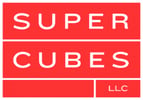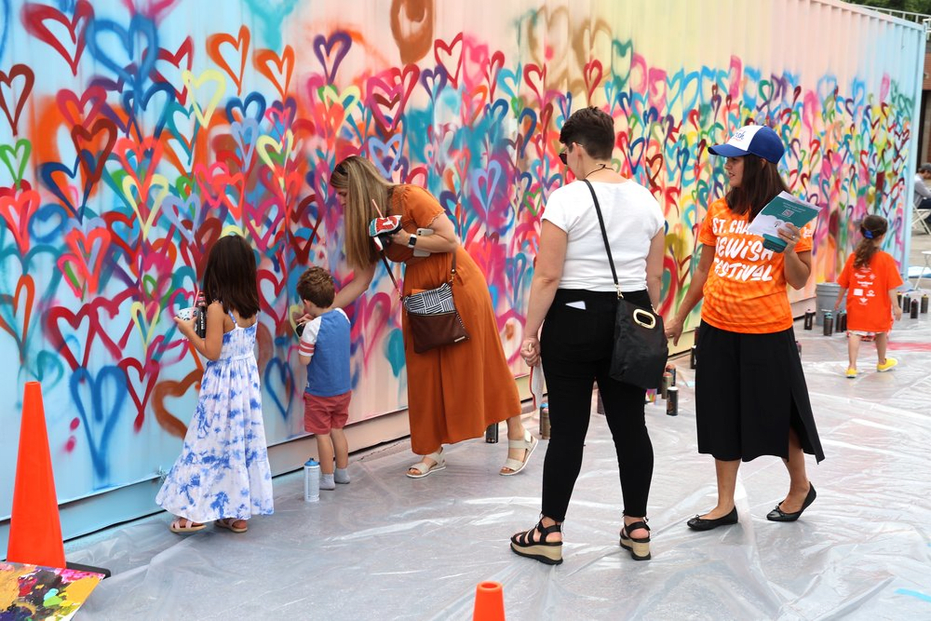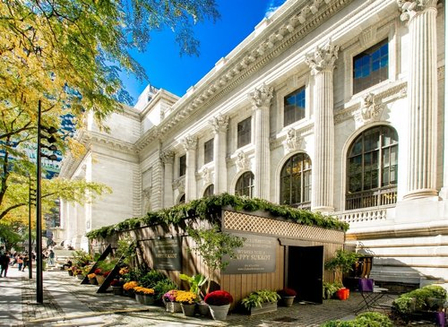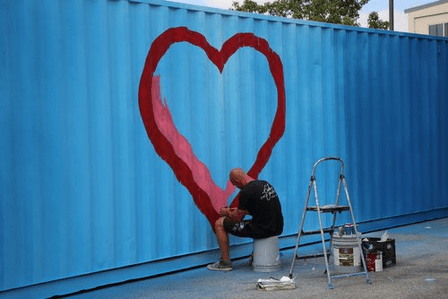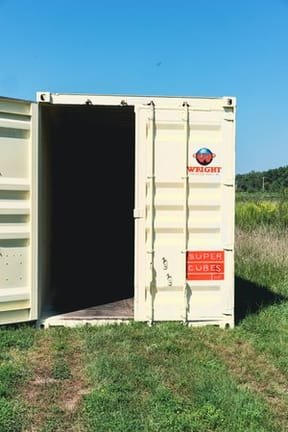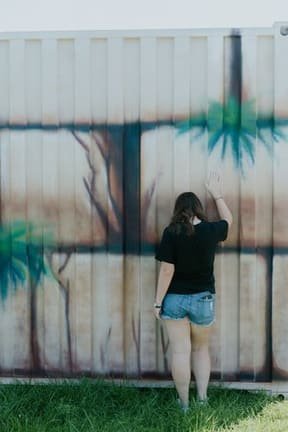Shipping Container Turned “Unity Art Sukkah”
I’m a big believer in the power of paying it forward; amplifying our positive influence by partnering with others to bring more goodness into the world. One cause that I feel strongly about is empowering people to be themselves, to be able to proudly share their uniqueness with those around them. Despite the current shipping container shortage, I felt compelled to make sure that the Chabad Jewish Center of St. Charles County was able to create their “Unity Art Sukkah” to increase Jewish pride and awareness and help thousands feel like they belong.
I hope it will inspire you to use your resources — time, energy, finances, and wisdom — to amplify positive causes and bring more goodness to the world.
Rabbi Chaim Landa
One day this past May, as I sat at my desk after a very long workday, I got a call from someone who introduced himself as “Rabbi Chaim Landa of the Chabad Jewish Center of St. Charles County; Zack Smithey told me to call you.”
I’m no stranger to St. Charles, a large county in the central eastern part of Missouri. In fact, when artist Zack Smithey and his wife Brie -- who live in St. Charles -- wanted to build their home out of shipping containers, they reached out to us at Super Cubes to secure the containers. I joined them for “crane day,” the day the containers were stacked on their foundations to create their iconic home.
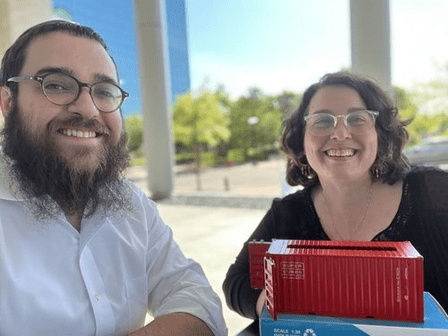
Pictured: My first in-person encounter with my enthusiastic friend Rabbi Chaim Landa, of St. Charles, Missouri, at our first meeting near the Mall of America in Bloomington, MN. Note the model shipping container I brought along so we could talk about some unique alterations to use the container as a sukkah. Credit: Rabbi Chaim Landa
If Zack was the one referring the rabbi to me, I knew off the bat that this was a cause worth listening to. The man on the phone explained that he wanted to secure a container for a project he had in mind: “I want to build a sukkah using a shipping container,” he said.
Wow, I thought. That’s a new one.
“Those don’t have a roof, right?!” I asked. I had a hard time picturing exactly what a sukkah looked like, but I was almost certain it couldn’t have a permanent roof.
A sukkah is a greenery-topped hut Jewish people construct for the holiday of Sukkot, the Jewish Festival of Tabernacles. I’m no stranger to creative uses of shipping containers — I’ve helped build everything from shrimp farms to reconstructing Shakespeare's Globe Theater out of them — but this was a first for me.
I felt a connection right away. Even on the phone, Chaim’s enthusiasm was infectious. He told me how excited he was to get this project done. “I don’t have a big budget, but I really want to do this. I have Zack onboard to facilitate the art; how can we take this to the finish line?”
I get a lot of requests for containers from people just saying, “can you donate one,” — without any of their own investment. It is not feasible for me to support most such requests, particularly given the increase in container costs during the pandemic. Here it was “I’ve gotten us part way there, but I’m not sure if it’s enough. Tell me if I’m far enough.” And I said, “Let’s see how much work we have to do to bridge the gap; how far apart we are on this.”
He called back a couple of days later. After realizing my company is located in the Twin Cities area, he called to say he would be attending a rabbinical conference in St. Paul the following week and he wanted to meet then. I told him to let me know when he was around and we’d make it work.
A week later, on a Friday morning, I got a text from Chaim. He was here, time was limited, but he really wanted to advance the project. Could I spare a few minutes? Sure, I could.
When I met with Chaim, it didn’t take long for his contagious enthusiasm to catch on. This was someone with a vision — and a plan to realize it. Chaim began to share that before he and his wife Bassy moved to St. Charles, they “dated the county” for about eight months. They would fly in and out of New York City and visit with Jewish families in the area, getting to know the community and developing a sense for how best they could serve them.
As they began this process, they kept hearing from people that they were “the only Jew in the county” — even though St. Charles County has nearly 6,000 Jewish residents.
Why?! Why did everyone think they were “the only Jew”?
As Chaim explained it, he and Bassy weren’t hearing about actual incidents of hate or antisemitism. (And now, more than two years since they’ve moved to the County, Chaim says he has personally seen and experienced the opposite: in fact, the people of St. Charles have been incredibly warm, welcoming and accepting.)
But what the Landas were hearing about was people’s perceptions and feelings; something he refers to as “perceived antisemitism.” People felt that if they identified proudly as Jews, their neighbors, friends and/or co-workers would look and behave towards them differently.
They felt they would somehow be “othered”...
Think about it.
It takes a huge amount of courage to share your faith when you think you’re the only one in the room with those beliefs — never mind when you think you’re the only one with those beliefs in your entire county!. As a result, people weren’t sharing their Jewish identity; it just felt too “risky.”
I knew what he meant because it’s exactly how my husband and I have sometimes felt.
My husband is Bengali, and proud of his culture. But we often felt like we just didn’t belong. As an interracial family, I understand that feeling of otherness all too well.
And the Jews in St. Charles were experiencing that very same thing; 500 miles away.
Before moving to St. Charles, one of the events Chaim and Bassy planned was a Sukkah Party. A local Jewish family agreed to host the event by allowing the Landas to construct a sukkah on their driveway. It would be a canvas sukkah that can be built in under an hour, and would be disassembled right after the party. Still, a sukkah is something that sticks out in suburban America. Building a sukkah in front of your home is like putting up a giant neon sign that says, “I’m Jewish.”
The morning of the event, the hosts reached out and let Chaim and Bassy know that they were very sorry, but they would have to back out of their commitment to host. They were just too concerned about what the neighbors may feel. Despite efforts to get an alternative host — Chaim and Bassy asked almost everyone who had RSVP’d — they sadly had to cancel the celebration. Dozens of people wanted a chance to observe the holiday, but no one was willing to have this Jewish display on their driveway.
At this point, I was totally drawn in. This was my project now. Everything he was sharing about the community feeling alienated, feeling afraid to proudly showcase their identity — their story deeply resonated with me.
“I turned to Bassy and said that one day, sukkahs would dot the driveways of St. Charles County,” Chaim concluded. “One day, the Jewish people of St. Charles would feel like they belong.”
Chaim shared that he wanted to have the container in time for their mid-August St. Charles Jewish Festival. He was hoping to use the festival as a way to involve the community and prepare the container for the week of Sukkot.
I told him I definitely want to help make this happen and even made some inquiries as we were sitting there. We said our good-byes and concluded our short encounter, but not before actualizing our new friendship.
As an observant Jew, Chaim can’t travel or use his phone on Shabbat, the Jewish Sabbath, from Friday at sunset till Saturday after nightfall. This was late May, which meant Shabbat wouldn’t end in St. Paul until 9:43 p.m. on Saturday evening. Chaim had to be in St. Louis for a Sunday morning engagement and his Saturday night flight home was only about an hour after the conclusion of Shabbat. He’d have to hop in an Uber the moment Shabbat ended to make the flight, and he was worried that by that time, he’d no longer be able to check-in online and he’d lose precious time waiting in line at the airport check-in desk.
I offered to check him in and send him his boarding pass. He gave me his confirmation number and the correct spelling of his full name and when he got on his phone after Shabbat, his boarding pass was waiting for him, courtesy of yours truly. And yes, I was happy to hear that he (just!) made his flight and had landed safely at Lambert Airport in St. Louis… :)
St. Charles Jewish Festival
Mid-August of this year they hosted their Second Annual St. Charles Jewish Festival, where more than 2,000 attendees engaged with Jewish life and culture. There was Jewish cuisine from around the world, cultural crafts and world-class Jewish music.
Folks got a “passport” upon entering the festival, and it was stamped by actors portraying Jewish people from continents and cultures across the globe, who shared a snapshot of the communities they represented. It was a beautiful way to bring Jewish pride out into the open in a county where it had been hidden away for so long.
And I’m proud to say that the shipping container did take center stage as planned. Participants got to join Zack Smithey in decorating the container-turned-sukkah with hundreds of hearts, symbolizing the continued love and acceptance they know this sukkah will bring to St. Charles County.
Pictured: Artist Zack Smithey paints the shipping container soon-to-be “Unity Art Sukkah” during the Second Annual St. Charles Jewish Festival in mid-August of this year. Credit: Chabad Jewish Center of St. Charles County

The almost finished “Unity Art Sukkah” now sits on the Chabad Jewish Center’s rolling green property that will soon begin to bedeveloped incrementally as the community grows. Note the Jewish symbols incorporated throughout: the Shabbat candles, left, the menorah, center, and the arm wrapped in tefillin, right.
Credit: Chabad Jewish Center of St. Charles County
Unity Art Sukkah
After the festival, the Unity Art Sukkah was transported to the property of the future home of Chabad’s Jewish Community Center in O’Fallon, where it will headline the holiday’s observance in October. With the generous help of Wright Construction and its Vice President Nathan Bibb — who has been instrumental and encouraging of this project — a gravel pad will be installed to place the shipping container on and the roof will be removed while maintaining the structural integrity of the sukkah.
And as Jews the world over gather in their sukkahs this fall, St. Charles will — for the first time in a long time — have a giant and beautiful sukkah to call its own. It’s the first structure on the organization’s rolling green property that will soon begin to be incrementally developed.
One of the Landas’ first forays into bringing Jewish people together in St. Charles had ended with no sukkah. Now, the Unity Art Sukkah will proudly stand in St. Charles — soon to be followed, no doubt, by other sukkahs that will send a message of love and acceptance throughout the County each fall during the week of Sukkot.
Chaim tells me he still meets people who say “I’m the only Jew in the county,” but I know we’re making progress and, together, we will bring Jewish pride and awareness to St. Charles’ community, one sukkah at a time.
I, too, plan to visit a sukkah this year — perhaps making the trek to St. Charles or driving to the public sukkah at the Mall of America. I want to bring my young son and show him what it means to create a space for every person to celebrate their heritage. And one day, my son will be in the position to do what I am doing: helping others live proudly and remain true to their identity, unafraid of what others might think.
More About the Chabad Jewish Center of St. Charles County
Chaim and Bassy moved to St. Charles in 2020 with their two daughters a few months after the Sukkot disappointment and weeks before the Covid lockdown, launching the Chabad Jewish Center of St. Charles County, the County’s sole Jewish center.
Chabad is a Jewish organization that is focused on creating spaces where every Jew feels at home. There are Chabad Houses in all 50 U.S. states and in more than 100 countries around the world. They are inspired by the teachings of the late Rabbi Menachem M. Schneerson, affectionately known as “the Rebbe.”
Born in 1902 in Ukraine, the Rebbe experienced overt antisemitism of the worst kind, surviving pogroms as a child and fleeing the Nazis as they swept through Europe. The Rebbe engineered a post-Holocaust Jewish renaissance, and his representatives bring a sense of Jewish pride and belonging to the communities they serve.
The Landas have been working hard to do just that. In fact, they recently opened St. Charles’ first-ever Jewish preschool, The Gan St. Charles. Steve Ehlmann, the County Executive, summed up the goodness they have been creating by saying, “We’re witnessing a Jewish revival in our county.”
September 14, 2022
